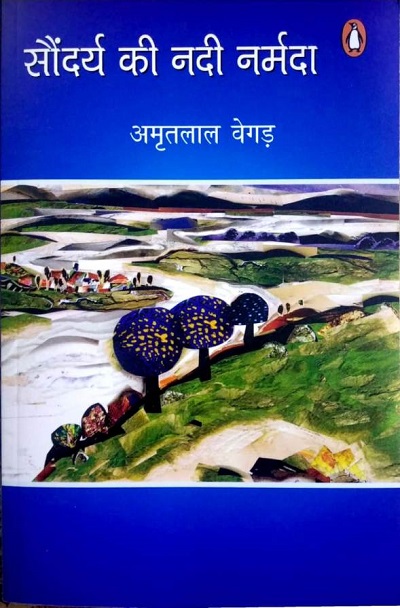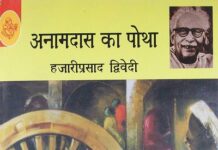Narmada Parikrama has been on my mind for quite some time now. I read about it in some scriptures and then a lot on internet. Someone recommended reading Saundarya Ki Nadi Narmada by Amritlal Vegad. It took me someone to get my hands on this book but I can not thank enough the person who recommended it. It is a masterpiece.
Amritlal Vegad ji did the Narmada Parikrima or parkampa as it is mentioned in the book in parts and partially but still this book is a must read. One of the reasons for this is that he did the parikrama before any dams were built on the river. This means the river was exactly as it would have been for eons, taking its natural course, uninterrupted, talking to the rocks and negotiating her way through them.

This means what Amritlal ji saw and wrote about is lost forever with building of dams. The river is now being controlled by humans to take advantage of it. It is not a free-flowing river anymore on whose banks the humans would come to live. This also means that the expanse of the yatra has increased. It is a lament that many of us would have that we can no longer see what the author saw and experienced.
Buy Saundarya Ki Nadi Narmada on Amazon
Narmada is one of the few rivers whose parikrama or circumambulation is very popular. Pilgrims take years to do it slowly on foot, walking along the river, always keeping it on their right – the more auspicious side. Narmada Mahatmya puts her higher in hierarchy above Ganga who they say may be the best but Narmada is the older of the two. They also say that to get Punya, you have to take a dip in Ganga, while just the darshan or view of Narmada gives you Punya.
I had met the women doing this parikrama at ghats of Narmada in Maheshwar. They are the most inspiring travelers I have ever met.
Author did his yatra starting from his home in Jabalpur, although traditional pilgrims would mostly start from Omkareshwar or from Amarkantak where the river originates. People who live on Narmada banks, have this advantage to start from home and end the pilgrimage at home.
Following your own Yatra
Being a working professional and a householder, he also does the yatra in parts – starting from where he left last. I think this is an interesting way to do a long yatra balancing your responsibilities and your calling. Like a wise woman told the author – it does not matter if you consume the Bundi Laddu in one go or break it and eat it – it gives you the same taste.
All through his walking around Narmada, he had young men who would do the lifting a cooking for him. How I wish I could have a team of students helping me in my travels. Everywhere in the evenings, they describe the singing and dancing by the locals. The folk songs were composed, or re-hashed for new situations and nearly everyone was an artist.
Music as part of Life
It seems singing and dancing was a common pastime before the ubiquitous screens took over and isolated all of us. It gave me a sense of deep loss as we have outsourced all our creativity to a bunch of people, assuming we can not compose or dance spontaneously. He compares folk songs to a Pugdundee – that is created by no one person but by collective efforts of everyone who walks past it. Towards the end of thebook he says to sing and dance yourself is entertainment of first grade and watch others do it on TV, a secondary source which can never give you pure joy.
At one place, he attended the wedding of a mango tree with Chameli vine. It is only after this ritual that people start consuming Mangoes of the new tree.
His walk through the Shoolpani ki Jhadi area dominated by tribal bandits is hilarious. The areas dominated by Bhil tribals were known to leave the pilgrims with nothing but the minimal clothing. So, the author made his preparations with the help of the police, who in turn make his realise that they were human too.
Learnings from the Book
Some epic lines from the book and my learnings
- जहाँ कोलाहल नहीं रहता, वहां कलरव सुनाई देता है – When is there is no noise, you hear the chirping of nature. Here he meant the chirping of Narmada.
- Fields are treated as Lakshmi and author was asked to remove shoes while walking through agricultural fields.
- Taste is neither in the tongue nor in the sweet but in the coming together of both. Similarly, Atma and Body are relevant when they come together as one.
- Sharad Purnima is the night of coronation of Moon – the day Krishna did his Ras Leela. Moon is a Ramta Jogi – a wandering minstrel.
- In the day she is Narmada, in the night she is Reva (a word that etymologically comes from sound). In the day she is Drashya or seen, but in night she is Shravya or Heard.
- Life should have both the discipline of Sun and the free will of moon. There should be a balance between discipline and enjoying a care-free life.
- Amarkantak is also known as Mekal and Narmada Mekalsuta.
- Lamp of love takes time to be lit but the fire of envy spreads fast.
- Jilahari Parikrama – Where the pilgrim does not cross the sea, so they end up walking the circumference of river twice.
- He talks about the stages of Narmada when she is in Vanvasa or flowing through forests or Agyatvasa when she temporarily flows through rocks and is invisible. He calls Dhuandhar – Kunjgali of Marble, a word that is typically used for narrow lanes of Vrindavan. He talks about the different Rasas or moods of river at different places. Her move from rocky region to sandy shores is called the shift from stone age to sand age.
- Gakad (something like Bati or Litti) is Prakriti (nature), Roti is Sanskriti or culture and Puri-Parantha are Vikriti or imbalance.
- Khet – where crops grow. Khalihaan – where cut crops are kept.
- Narmada is the Yagyopavit – the sacred thread around the body of this earth or may the Bharat.
- Parikrama and Prakrama come from the same root – Kraman – meaning to move ahead.
- Naramada is created by five elements – Water, Rocks, Waterfalls, Sound and Turns.
- River is a born traveller, starts traveling the moment it is born.
- Earlier all things we enjoyed were outside – rivers, hills, forests, tirthas, flowers, birds. Today, it is inside a box and now all is in our mobile screens.
Must Read Travel Book
There is a beautiful poem connecting Water, Ocean, Clouds and River.
I learnt so much about analogies in literature. You need both a good command on the language and a deep-rooted knowledge of the culture you are writing about. Connecting the dots of what you know and what you experience, an appreciative eye is what I hope to include in my own travels. I am going to look at Narmada very differently as and when I get to walk around her.
Saundarya Ki Nadi Narmada is in Hindi, so if you can read it, highly recommended book to read.








